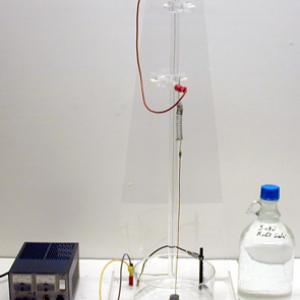College of Liberal Arts & Sciences
5H30.56 - Faraday's Engine
Pour saturated salt water solution into the Pyrex dish to a level just below the top of the magnet that is attached to the center of the dish. Lower the copper electrode into the solution so that about 1/4 to 1/2 inch of the tip is submerged. Turn on the power supply and observe the rotation. Vary the voltage and observe that the distance from the electrode to the magnet is proportional to that voltage.
SPECIAL NOTES ABOUT THIS DEMO: This demo was originally done using mercury as the liquid conductor. Although this may still be done there are some hazards you should be aware of. Besides the environmental hazards, the mercury will also act as a dead short on the power supply. This will lead to maximum amperage being applied with the possible evolution of mercury vapor and the melting of the copper electrode being results.
The salt solution eliminates these dangers. The solution will carry a maximum or 2 to 3 amps eliminating strain on the power supply and electrode. There will be evolution of HCL gas at one of the electrodes but for the short periods that this demo is usually run this is not a problem.
Also be aware that the direction of the current is critical when using the salt solution. Connections should be + to + and - to - as shown in the pictures. These can be reversed but only for short periods of time as the copper portion of the electrode that is submerged will dissolve when run in this direction for more than 2 or 3 minutes.
- James Lincoln and Nick Moore, "Five Fresh Lorentz Force Demos", TPT, Vol. 57, #8, Nov. 2019, p. 572.
- Thomas B. Greenslade Jr., "Devices to Display Electromagnetic Rotation", TPT, Vol. 34, #7, Oct. 1996, p. 412.
- Samuel Devons, "The Search for Electromagnetic Induction", TPT, Vol. 16, #9, Dec. 1978, p. 625.
- A. K. T. Assis and J. P. M. C. Chaib, "Ampere's Motor: Its History and the Controversies Surrounding its Working Mechanism", AJP, Vol. 80, #11, Nov. 2012, p. 990.
- Thomas B. Greenslade Jr., "Faraday's Rotating Wire (photo)", AJP, Vol. 76, #3, Mar. 2008, p. 249.
- Melba Phillips, A. P. French, and Jon Rosenfeld, "A Magnetic Curl Meter", AJP, Vol. 40, #2, Feb. 1972, p. 330.
- T. Walley Williams, III, "Simple Apparatus for Three Lecture Demonstrations", AJP, Vol. 31, #1, Jan. 1963, p. 42.
- G. D. Freier and F. J. Anderson, "Ei-13", A Demonstration Handbook for Physics.
- Richard Manliffe Sutton, "E-142, 143", Demonstration Experiments in Physics.
- John Henry Pepper, "Henry George Hine", The Boy's Playbook of Science, p. 211.
- "Electricity Harnessed to a Flow of Inventions", When, Where, Why and How it Happened, Readers Digest.
Disclaimer: These demonstrations are provided only for illustrative use by persons affiliated with The University of Iowa and only under the direction of a trained instructor or physicist. The University of Iowa is not responsible for demonstrations performed by those using their own equipment or who choose to use this reference material for their own purpose. The demonstrations included here are within the public domain and can be found in materials contained in libraries, bookstores, and through electronic sources. Performing all or any portion of any of these demonstrations, with or without revisions not depicted here entails inherent risks. These risks include, without limitation, bodily injury (and possibly death), including risks to health that may be temporary or permanent and that may exacerbate a pre-existing medical condition; and property loss or damage. Anyone performing any part of these demonstrations, even with revisions, knowingly and voluntarily assumes all risks associated with them.
